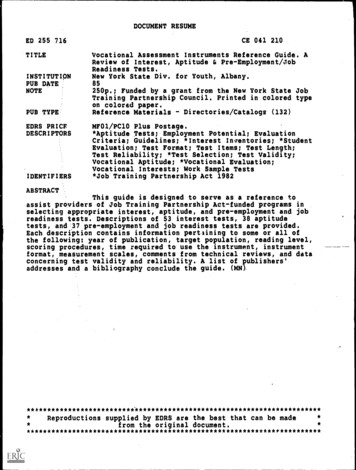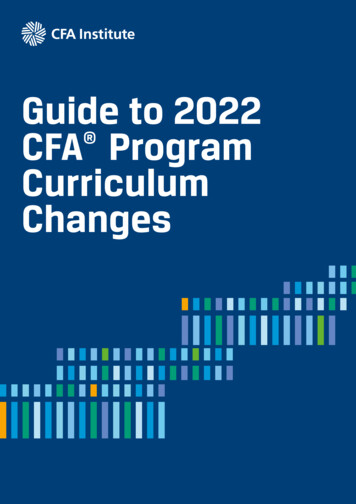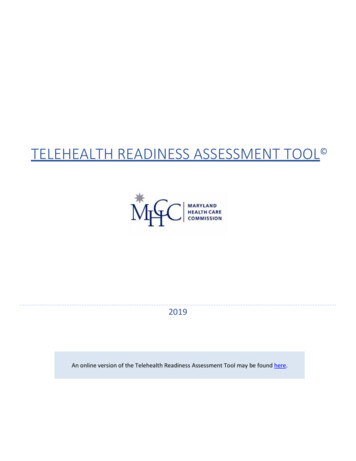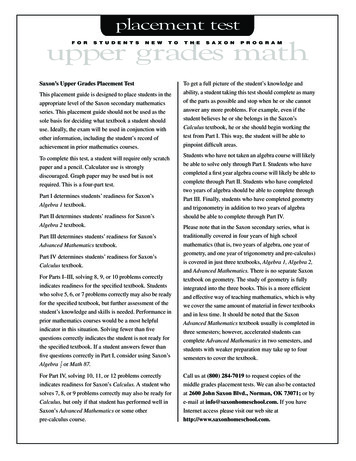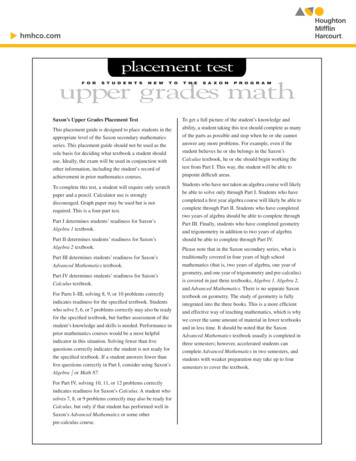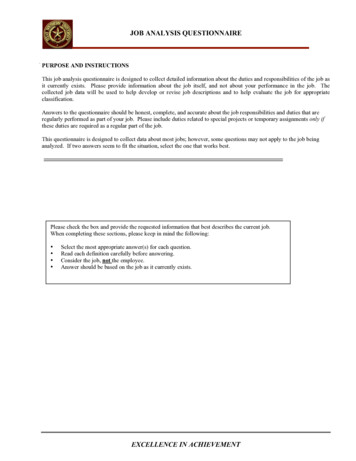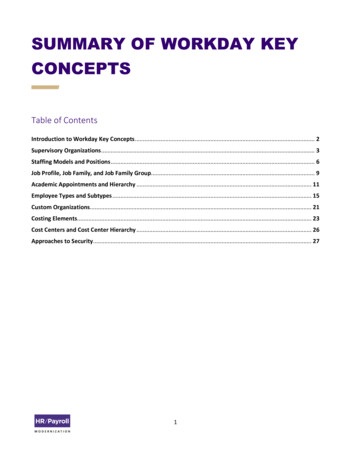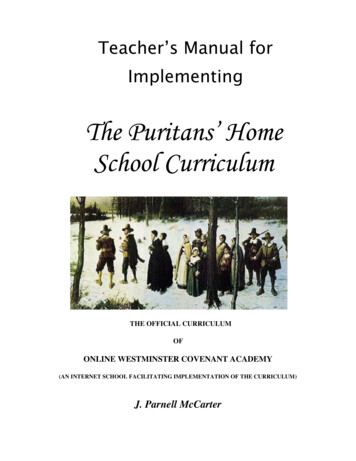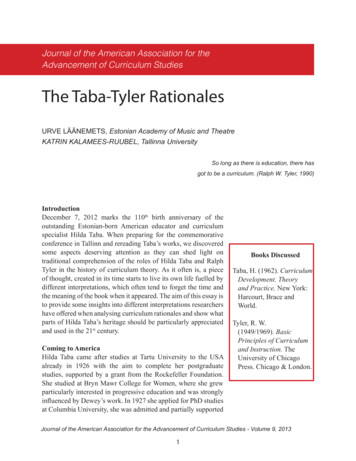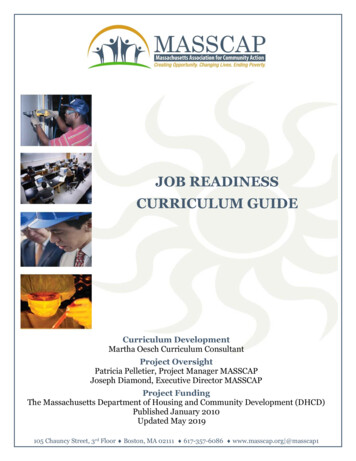
Transcription
JOB READINESSCURRICULUM GUIDECurriculum DevelopmentMartha Oesch Curriculum ConsultantProject OversightPatricia Pelletier, Project Manager MASSCAPJoseph Diamond, Executive Director MASSCAPProject FundingThe Massachusetts Department of Housing and Community Development (DHCD)Published January 2010Updated May 2019105 Chauncy Street, 3rd Floor Boston, MA 02111 617-357-6086 www.masscap.org @masscap1
Greetings!The Massachusetts Association for Community Action (MASSCAP) is pleased to present this updatedJob Readiness Curriculum Guide as an “open source” document.MASSCAP is the statewide association of the 23 Community Action Agencies (CAAs) operating inMassachusetts. Through the combined skills and vision of its members, MASSCAP works to enhancethe ability of each agency to better serve its clients. We work with the Massachusetts Department ofHousing and Community Development (DHCD) and other state agencies to open doors to economicprosperity for low-income Massachusetts residents.Our Mission: To strengthen and connect the statewide network of Community Action Agencies andcollectively advocate for an end to poverty.Our Vision: All MA residents will be able to meet their basic needs, access economic opportunities, buildstrong communities and move toward prosperity.The MASSCAP Training Center (MTC) offers training and resources to enhance the ability of communityorganizations to serve their customers, develop their staff and boards, improve operations, expandcapacity, and comply with funder requirements. The MTC taps into a network of experts and offers avariety of learning opportunities covering a wide range of topics for all levels of staff as well as boards ofdirectors of Community Action Agencies across the state.In 2009, MASSCAP and DHCD partnered to address the gap in the workforce development system inwhich many lower-skilled, low-income residence fall when attempting to access training or furthereducation to achieve economic self-sufficiency. With the assistance of a job readiness curriculumconsultant and workforce development specialist, MASSCAP’s Workforce Development Committee andDHCD, we designed an intensive, comprehensive, job readiness curriculum and project model whichwas piloted and evaluated at three Community Action Agencies in Massachusetts with 198 low-incomeadults, 28% of whom where homeless, 56% were TANF (welfare) recipients, and 68% were receivingfood stamps.Since its publication in 2010, MASSCAP (and more recently the MTC) has trained over 500 CommunityAction and other nonprofit agency staff on the use of the curriculum with their client populations inprograms such as adult education, housing self-sufficiency, homeless shelters, job training, financialassistance centers and Head Start.The curriculum guide was updated in 2019 and was made an “open source” document which is availableat the MASSCAP website: www.masscap.org. While we strongly recommend that users of thecurriculum attend a five-hour training to maximize the efficacy of the use of the guide and lessons, wefelt it was time to share this valuable and effective tool with all who are interested in providing thoseliving in poverty with the pre-employment skills that will help them to move forward in their careerpathways.For further information on how to receive training on the job readiness curriculum please contact JessBenedetto, MTC Training and Resource Director at: jessbenedetto@masscap.orgi
MASSCAP Job Readiness Training ProjectCurriculum GuidePublished January 2010Updated May 2019Notes:1.2.3.4.5.Curriculum is 120 hours.Theme modeling the workplace throughout the training.Activities take into account that some students may be working and others may not.Extension/Independent Activities include the use of technology where appropriate.Students build their portfolio throughout the program, and the portfolio includes the developmentof their resume.Table of ContentsExploring My Story, Creating My Path (10 hours) . 1 Getting to Know Your Class . 1 Introduction to Creating a Personal Vision . 3 Creating Your Personal Vision . 5 Identifying Your Personal Values . 8 Economic Self-Sufficiency as a Core Value . 11 The Circle of Influence. 14 My Goals for the Job Readiness Program . 17 Accessing Resources at My CAP Agency . 19Career Readiness Skills (30 hours) . 20 How People Get Jobs . 20 Influence of Family and Friends . 23 Things I Like . 25 Things I Have Done . 27 Identifying Skills . 30 Identifying Job Values . 34 Putting It All Together—Interests, Skills, and Values . 38 Using the Internet to Learn About Occupations . 40 Informational Interviews. 44 Job Fairs/Career Fairs . 49 Job Shadowing . 52 Career Ladders . 61 Exploring Options for Further Education. 62 Smart Consumer of Education . 64 Goal Setting. 67ii
Making a Career and Education Plan . 73Preparing to Enter the World of Work (15 hours) . 77 What a New Worker Needs to Know . 77 Understanding Employer Expectations. 80 Your Attitude. 82 Do’s and Don’ts in the Workplace . 86 Identifying and Coping with Problems on the Job . 88 Time Management. 91 Dress for Success . 95 Planning Ahead . 99 Budgeting for Food and Nutrition . 101Soft Skills to Get and Keep a Job:Communication and Interpersonal Skills (25 hours) . 104 What Did You Hear?. 104 Being Assertive, Not Aggressive . 106 Active Listening Skills . 109 Practicing Listening Skills . 112 Body Language: Presenting a Positive Image . 119 Understanding Your Personal Style . 122 Working with Diversity . 124 Accepting Direction/Criticism . 131 Defining Conflict and Its Causes . 137 Resolving Conflict in the Workplace . 141 Working with Others on a Team . 144 Coping with Change . 146Financial Foundations for Success (20 hours) . 147 Making a Dream Collage . 147 Feelings and Values About Money . 149 Budgeting Basics . 152 The Envelope System . 154 How to Budget . 157 The Bean Game . 162 S.M.A.R.T Financial Goals . 164 Credit and Debt . 167 Banking Fundamentals . 170Job Search and Retention (20 hours) . 173 The Hidden Job Market . 173iii
Networking: Your Path to the Hidden Job Market . 175Completing a Job Application . 179Completing an Online Job Application . 181Developing a Resume . 182Keeping Track of Your Job Search Activities. 186Telephone Etiquette . 188Job Search on the Internet . 190Preparing for an Interview Basics . 192Planning for a Successful Interview . 195Mock Interviewing . 198Follow-Up to Interviews . 200Timekeeping Practices . 202Understanding Your Paycheck and Benefits . 205Getting Ready for the First Day of a Job . 208On the Job Problem Solving . 210Bibliography . 212iv
How to Use This GuideThe MASSCAP Job Readiness Guide was developed for use by staff of Community Action Agencies and othersocial service organizations who work with low-income, lower-skilled adults seeking to improve their economicstatus through employment and who lack the basic job readiness skills (“soft skills”) to begin a pathway toemployment. Some organizations have also used the guide with older youth with success.While MASSCAP highly recommends that social services staff attend the six-hour training on the use of thecurriculum to get the most out of it, in 2019 we determined that making it an “open source” document wouldprovide even more opportunities for low-income populations to benefit from its use. We do ask that you use theguide “with fidelity,” that is, teach the lessons exactly as laid out. They have been designed to take intoconsideration many needs of the adult learner population.The more than 500 social services staff that have been trained on using the curriculum range from adult educationteachers, to homeless shelter counselors, to job training program instructors, to Head Start staff, to American JobCenter staff, and more. Some have implemented it as an intensive 20 hour a week program, some have used it asa workshop series for job seekers, others as daily classroom activities integrated with other education and trainingclasses, and others as a one-on-one case management or coaching tool. The flexibility of the guide allows for usein many different ways.The curriculum guide includes six units with over 70 individual lessons, most of which have “extension activities” inaddition to the primary lesson. The five units are: Exploring My Story, Creating My Path (Self-exploration)Career Readiness SkillsPreparing to Enter the World of WorkSoft Skills to Get and Keep a Job (Communication and Interpersonal Skills)Financial Foundations for Success (Basic Financial Literacy)Job Search and RetentionLessons are organized into the following components: Lesson NameLearning ObjectiveMaterials NeededVocabularySCANS CompetenciesMethodologyTimeActivity Instructions and Extension ActivitiesIntegrated TechnologyWe wish you success in implementing the MASSCAP Job Readiness Curriculum Guide with your low-incomecustomers. If you are interested in attending the six-hour training please contact Jess Benedetto:jessbenedetto@masscap.org.v
Exploring My Story, Creating My PathLesson—Getting to Know Your ClassLearning Objective:To learn about fellow students and what they have incommonMaterials Needed:Magazines, markers, and other items for making a collageVocabulary:collageSCANS Competencies:Interpersonal: Participates as Member of a Team, Workswith Diversity; Personal Qualities: SociabilityMethodology:Small group activityTime:60-90 minutesInstructions: Explain that to help students get to know each other, they are going to work together onmapping their community. Divide into small groups of 3-4. Give each group a big sheet of butcher block paper, markers,magazines, scissors, and glue. Have each group make a collage of their community thatincludes, but is not limited to, the following:o Fire/police stationo Libraryo Town hallo Schoolso Where you grocery shopo Where you cash checks or banko Where you buy clotheso Where you buy gaso Where you get coffeeo Your drugstore or pharmacyo Your place of worshipo Where you rent videos/go to movies/other entertainmento Where you vote Have each group share its map of their community. Share anything new they learned abouttheir community and its resources. Emphasize the importance of using the class as a place tolearn about resources throughout the program.Extension/Independent Activities: Have students write about what they most like about their community and what they would liketo change.1
Have students choose one new resource they learned about during the group mapping andthen visit that resource and write about it.2
Exploring My Story, Creating My PathLesson—Introduction to Creating a Personal VisionLearning Objective:To learn what a personal vision is and begin to identify theirown vision for their career and life.Materials Needed :Handout: “Introduction to Creating a Personal Vision”Vocabulary:vision, uniqueness, perspective, developmental,professionalSCANS Competencies:Thinking Skills: Seeing Things in the Mind’s Eye, CreativeThinking; Personal Qualities: Self-ManagementMethodology:Group brainstorm, individual follow-upTime:30-45 minutesInstructions: Brainstorm and record what it means to have a Personal Vision. Explore why this is important. Refer to the “Introduction to Creating a Personal Vision” handout for talking points. Explain that Personal Visions can be expressed through pictures and writing. On the board,draw a sample picture of your own Personal Vision for the life you want. Distribute the handout, “Introduction to Creating a Personal Vision.” Review it with students. Ask students to draw their own Personal Vision on the paper. Depending on the comfort level of students, share some of the visions as a large group or inpairs.Extension/Independent Activities:Ask students to write an answer to one or more of the following questions or interview another personabout their answers: What are the 10 things you most enjoy doing? Be honest. These are the 10 things withoutwhich your weeks, months, and years would feel incomplete. What three things must you do every single day to feel fulfilled in your work? What are your five or six most important values? When your life is ending, what will you regret not doing, seeing, or achieving? What strengths and accomplishments of yours have other people commented on? Whatstrengths do you see in yourself?3
Introduction to Creating a Personal VisionYour Personal Vision is the picture of the life you want to build. Your Personal Vision captures yourLife’s Story: it describes who you are, where you have been, and what you hope to create for yourselfand your community. Your Personal Vision describes your future—where you want your Life’s Storyto lead.You are the main character in Your Story, bringing your personal values and skills along the path.Exploring Your Story is key to your career and professional development for many practical reasons: Having a clear picture of how you want Your Story to unfold helps establish a destination:Where do you want to go? What will help you get there? Understanding your personal uniqueness, perspective, and qualities will help you understandthe strengths and developmental needs you bring to your professional path.The next few lessons will give you some tools and food for thought in creating a Personal Vision.You’ll be asked to think about all aspects of your life and the core values that you live by.In the space below, draw a picture of Your Story and Your Personal Vision for the life you want tobuild.4
Exploring My Story, Creating My PathLesson—Creating Your Personal VisionLearning Objective:To develop their own vision for their career and life.Materials Needed :Handout: “Personal Vision Worksheet”Vocabulary:hobbies, brush strokes, factor, life purposeSCANS Competencies:Personal Qualities: Integrity/Honesty, Self-Esteem; BasicSkills: WritingMethodology:Group discussion, individual follow-upTime:30-60 minutesInstructions: Distribute and walk through the handout, “Personal Vision Worksheet,” to ensure that allstudents understand what each section is asking. Ask for examples as you review each question. Stress that there are no right or wrong answers. The goal is to reflect on what is mostimportant to them. Either have students complete the worksheet in class or have them do it for homework.Extension/Independent Activities: Group sharing activity—once students have completed their “Personal Vision Worksheet,” askif there were any surprises as they answered the questions. What questions were hard toanswer? What things did students add for question 10? For homework, ask students to write a paragraph describing their Personal Vision. Ask students to watch a video vision statement at the link below and write how it relates totheir Personal e21324005
Personal Vision WorksheetThere are many things to look at in a Personal Vision: who you want to be, what kind of life you wantto create, and the material objects that you want in your life are just a few of the brush strokes thatmake up the total picture. Please begin your exploration of Your Personal Vision by writing youranswers to the questions below.1) You. What kind of person do you want to be? What qualities do you admire in others and wouldlike to possess?2) Health. How does your physical health factor into your life vision? What aspects of your healthwould you like to improve? In what ways are physical exercise and healthy eating habits a part ofyour vision?3) Home. What living situation do you want to create?4) Material Things. What things would you like to own or have in your life?5) People. Who else is in this picture of your future vision? How are your relationships with friends,family, co-workers, community members, and others?6) Life Purpose. Your life has a unique purpose—fulfilled through what you do, your relationships,and the way you live. What is this purpose?6
7) Work. What would you like to create in terms of your career or profession? How much energy areyou willing to spend to create this situation? How does your chosen work impact others?8) Community. How is community a part of your life’s vision? What do you give to your community?What do you receive?9) Hobbies and Interests. What activities, hobbies, or interests will complete this picture?10) What Else? What else could you create or have in your life?7
Exploring My Story, Creating My PathLesson—Identifying Your Personal ValuesLearning Objective:To help students identify what their personal values areMaterials Needed :Handouts: “Identifying Your Personal Values” (two pages)and “Personal Vision Worksheet” (completed by students)Vocabulary:serenity, integrity, ethical practice, competenceSCANS Competencies: Personal Qualities: Responsibility; Basic Skills: Listening,SpeakingMethodology:Large group discussion followed by individual and pair workTime:90 minutesInstructions: Ask students to define what values are. Explain that values are the guides that give direction toour lives. Our values show what we do with our limited time and energy. Have students pull out their completed “Personal Vision Worksheets.” Ask them to look at theworksheet and identify what values are illustrated by what they wrote. Share examples ofvalues shown as a large group. Then distribute the handout, “Identifying Your Personal Values.” Review the directions and theword list. Pay special attention to defining words that may be unfamiliar to students. Ask students to complete the first page of the worksheet in class. Then in small groups (2-6 people), students share their own top five to seven values anddiscuss the following questions:1. What do I do in my life to show that these values are important to me?2. What are the barriers that make it hard to keep these values at the top of my priorities?3. What have I learned about myself from this discussion? Each small group reports to the whole class about their discussion.Extension/Independent Activities: Have students complete page 2 of “Identifying Your Personal Values.” Write a paragraph or essay describing how their values translate into actions in their lives. Students record the top five values of all students in an Excel graph or pie chart. Students write their paragraph or essay in Microsoft Word.8
Identifying Your Personal Values (Page 1 of 2)Directions1. Scan your Personal Vision Worksheet. What does the worksheet say about what you value in your life? Circle thevalues on this list that match most closely.2. Identify other values that relate most closely to the values you circle, and put them in groups that make sense to you.3. Continue grouping and selecting until you have chosen the five to seven values that are most important to you.AchievementFinancial orityAdventureFriendshipsPrivacyAffection (love and caring)GrowthPublic serviceArtsHaving a familyPurityChallenging problemsHelping other peopleQualityChange and varietyHelping societyQuality relationshipsClose eReligionCompetenceInner y/accountabilityCooperationIntellectual vityJob tionDemocracyLeadershipStabilityEcological awarenessLocationStatusEconomic securityLoyaltyTime freedomEffectivenessMarket positionTruthEfficiencyMeaningful workWealthEthical ntNatureWorking with othersExpertiseOpen and honestWorking aloneFameOrderFast livingPersonal developmentFast-paced workPhysical challengeThis list of values is adapted from page 210 of “The Fifth Discipline Fieldbook,” by Peter Senge9
Identifying Your Personal Values (page 2 of 2)Write your seven most important values in the numbered boxes on the left in the table below. Then,for each value, write your personal definition of that value: what does each of these values mean toyou?ValueWhat This Means to Me123456710
Exploring My Story, Creating My PathLesson—Economic Self-Sufficiency as a Core ValueLearning Objective:To introduce concepts of economic literacy and begin tounderstand family self-sufficiency as a core valueMaterials Needed :Handout: “The Self-Sufficiency Standard Worksheet” anddata from Massachusetts’ county/city family economicself-sufficiency standards found :self-sufficiencySCANS Competencies: Basic Skills: Arithmetic/Mathematics; Resources: Money;Information: Acquires and Evaluates InformationMethodology:Presentation and large group discussionTime:30-45 minutesInstructions: Mini-presentation to students: (Be sure to first read about the Living Wage model on the g economically self-sufficient means being able to live, work, pay taxes, and raise a family inMassachusetts without public or private subsidies. Economic self-sufficiency is key to being able tomove along your chosen path, which means that Your Personal Vision should include some element andunderstanding of your own financial and economic health.In 2004, the Living Wage Calculator was created by Amy Glasmeier, which showed what it really takesto live, work, and raise a family in each of the fifty states. Families and individuals working in low-wagejobs make insufficient income to meet minimum standards given the local cost of living. MIT developed aliving wage calculator to estimate the cost of living in a community or region based on typical expenses.The tool helps individuals, communities, and employers determine a local wage rage that allowsresidents to meet minimum standards of living.The Living Wage will become a personal tool to use along your path. It will help you: Create financial goals and a budget that will allow you to support yourself and your family. Evaluate individual career goals and guide people toward employment choices that lead to selfsufficient wages. Influence your government representatives to help you get the support you need.11
Group activity: On the board, display a column with the categories in the “Typical Expenses” listed on the website.Chose a family type that best captures the experience of students in the class. Brainstorm what the living wage dollar amount should be for a family of that size in their county/city. Compare their answers to Living Wage Expenses for the county/city. Distribute copies of the data. Discuss how this information might inform their career and job choices.Extension/Independent Activities: Have students visit the website and complete a Living Wage Worksheet for their own family. Based on the class discussion, ask students to write about what they learned and what economic selfsufficiency means to them. Have students draft their monthly family budget in Excel using the same categories as the Living WageWorksheet.12
Living Wage WorksheetName: Date:County: City: Year:Annual ExpensesMy Family Type is(Fill in the following information from the Living WageChart for your town or region.)FoodChild CareMedicalHousingTransportationOtherRequired annual incomeafter taxesAnnual taxesRequired annual incomebefore taxesWagesLiving WageMy Family Type isPoverty WageMinimum Wage13
Exploring My Story, Creating My PathLesson—The Circle of InfluenceLearning Objective:To identify things within your control that can move youtoward your goalsMaterials Needed :Handouts: “The Circle of Influence” and “Reflections on theCircle of Influence”Vocabulary:influence, reflections, sphereSCANS Competencies:Thinking Skills: Reasoning, Problem Solving; PersonalQualities: Integrity/HonestyMethodology:Small group and individual workTime:60-90 minutesInstructions: Draw the “Circle of Influence” on the board. Describe what it is and its relationship to achievingyour goals. In small groups, have students list some of the things that fit in each circle. Have small groups share their ideas with the class. Distribute the two handouts, “The Circle of Influence” and “Reflections on the Circle ofInfluence.” Review the handouts and directions for “The Circle of Influenc
status through employment and who lack the basic job readiness skills (“soft skills”) to begin a pathway to employment. Some organizations have also used the guide with older youth with success. While MASSCAP highly recommends that social services staff attend
